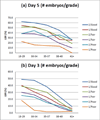Using the Society for Assisted Reproductive Technology Clinic Outcome System morphological measures to predict live birth after assisted reproductive technology
- PMID: 25217871
- PMCID: PMC4252875
- DOI: 10.1016/j.fertnstert.2014.07.1242
Using the Society for Assisted Reproductive Technology Clinic Outcome System morphological measures to predict live birth after assisted reproductive technology
Abstract
Objective: To model morphological assessments of embryo quality that are predictive of live birth.
Design: Longitudinal cohort using cycles reported in the Society for Assisted Reproductive Technology Clinic Outcomes Reporting System (SART CORS) between 2007 and 2011.
Setting: Clinic-based data.
Patient(s): Fresh autologous assisted reproductive technology (ART) cycles with ETs on day 3 or day 5 and morphological assessments reported (25,409 cycles with one embryo transferred and 96,093 cycles with two embryos transferred). Live-birth rates were modeled by morphological assessments using backward-stepping logistic regression for cycle 1 and over five cycles, separately for day 3 and day 5 transfers and number of embryos transferred (1 or 2). Additional models for each day of transfer also included the number of oocytes retrieved and the number of embryos cryopreserved.
Intervention(s): None.
Main outcome measure(s): Live births.
Result(s): Morphological assessments of grade, stage, fragmentation, and symmetry were significant for the day 3 models; grade, stage, and trophectoderm were significant in the day 5 model; inner-cell mass was significant in the models when two embryos were transferred. Number of oocytes retrieved and number of embryos cryopreserved were significant for both day 3 and day 5 models.
Conclusion(s): These findings confirm the significant association between embryo quality parameters reported to SART CORS and live-birth rate after ART.
Keywords: Embryo morphology; embryo fragmentation; embryo symmetry; live birth rate; trophoblast.
Copyright © 2014 American Society for Reproductive Medicine. Published by Elsevier Inc. All rights reserved.
Figures


Similar articles
-
A prediction model for live birth and multiple births within the first three cycles of assisted reproductive technology.Fertil Steril. 2014 Sep;102(3):744-52. doi: 10.1016/j.fertnstert.2014.05.020. Epub 2014 Jun 14. Fertil Steril. 2014. PMID: 24934487 Free PMC article.
-
Fresh embryo transfer after in vitro insemination of fresh vs. cryopreserved anonymous donor oocytes: which has a better live birth rate? A Society for Assisted Reproductive Technology Clinic Outcome Reporting System analysis.Fertil Steril. 2022 Apr;117(4):803-810. doi: 10.1016/j.fertnstert.2022.01.008. Epub 2022 Feb 23. Fertil Steril. 2022. PMID: 35216830
-
Cumulative live birth rates with autologous oocytes plateau with fewer number of cycles for each year of age > 42.Reprod Biol Endocrinol. 2023 Oct 23;21(1):94. doi: 10.1186/s12958-023-01144-z. Reprod Biol Endocrinol. 2023. PMID: 37872609 Free PMC article.
-
Guidelines for the number of embryos to transfer following in vitro fertilization No. 182, September 2006.Int J Gynaecol Obstet. 2008 Aug;102(2):203-16. doi: 10.1016/j.ijgo.2008.01.007. Int J Gynaecol Obstet. 2008. PMID: 18773532 Review.
-
SART CORS IVF registry: looking to the past to shape future perspectives.J Assist Reprod Genet. 2022 Nov;39(11):2607-2616. doi: 10.1007/s10815-022-02634-6. Epub 2022 Oct 21. J Assist Reprod Genet. 2022. PMID: 36269502 Free PMC article.
Cited by
-
Transfer the best and biopsy the rest? Blastocyst euploidy rates differ by morphology and day of biopsy.Arch Gynecol Obstet. 2021 Jan;303(1):249-258. doi: 10.1007/s00404-020-05746-5. Epub 2020 Aug 17. Arch Gynecol Obstet. 2021. PMID: 32808112
-
A validated model for predicting live birth after embryo transfer.Sci Rep. 2021 May 24;11(1):10800. doi: 10.1038/s41598-021-90254-y. Sci Rep. 2021. PMID: 34031492 Free PMC article.
-
Association between Number of Formed Embryos, Embryo Morphology and Clinical Pregnancy Rate after Intracytoplasmic Sperm Injection.Rev Bras Ginecol Obstet. 2016 Sep;38(9):465-470. doi: 10.1055/s-0036-1592338. Epub 2016 Sep 21. Rev Bras Ginecol Obstet. 2016. PMID: 27652995 Free PMC article.
-
Effect of Age and Embryo Morphology on Live Birth Rate After Transfer of Unbiopsied Blastocysts.JBRA Assist Reprod. 2021 Jul 21;25(3):373-382. doi: 10.5935/1518-0557.20200101. JBRA Assist Reprod. 2021. PMID: 33565291 Free PMC article.
-
Risks of nonchromosomal birth defects, small-for-gestational age birthweight, and prematurity with in vitro fertilization: effect of number of embryos transferred and plurality at conception versus at birth.J Assist Reprod Genet. 2021 Apr;38(4):835-846. doi: 10.1007/s10815-021-02095-3. Epub 2021 Feb 5. J Assist Reprod Genet. 2021. PMID: 33547526 Free PMC article.
References
-
- Tesarik J, Junca AM, Hazout A, Aubriot FX, Nathan C, Cohen-Bacrie P, et al. Embryos with high implantation potential after intracytoplasmic sperm injection can be recognized by a simple, noninvasive examination of pronuclear morphology. Hum Reprod. 2000;15:1396–1399. - PubMed
-
- Van Royen E, Mangelschots K, De Neubourg D, Laureys I, Ryckaert G, Gerris J. Calculating the implantation potential of day 3 embryos in women younger than 38 years of age: a new model. Hum Reprod. 2001;16:326–332. - PubMed
-
- Boiso I, Veiga A, Edwards RG. Fundamentals of human embryonic growth in vitro and the selection of high-quality embryos for transfer. Reprod Biomed Online. 2002;5:328–350. - PubMed
-
- Gardner DK, Sakkas D. Assessment of embryo viability: the ability to select a single embryo for transfer--a review. Placenta. 2003;24(Suppl B):S5–S12. - PubMed
Publication types
MeSH terms
Grants and funding
LinkOut - more resources
Full Text Sources
Other Literature Sources
Medical

